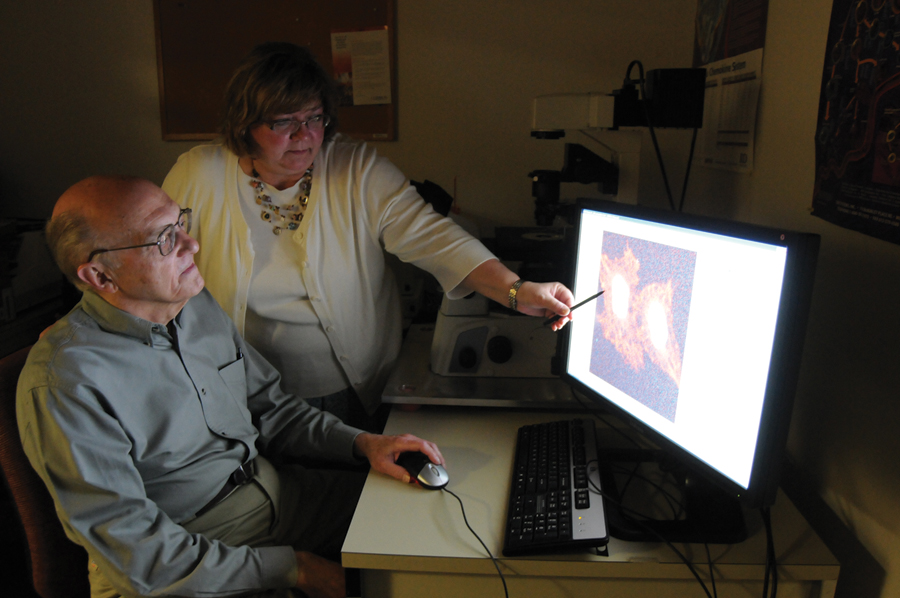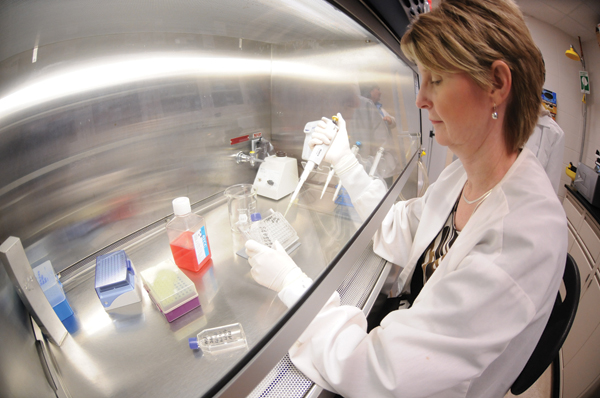killer raspberries
Jemma Everyhope-Roser
In the lab, they snuff out cancer cells. Will it work in people, too?
 Can raspberries help protect us from cancer? Lyn Larcom and Patilee Tate are studying that possibility, and the initial results look promising.
Can raspberries help protect us from cancer? Lyn Larcom and Patilee Tate are studying that possibility, and the initial results look promising.
Most of us have heard about antioxidants, which scientists think neutralize free radicals, the natural byproducts of mitochondria burning energy for the cell. Free radicals may damage DNA and initiate tumors.
“Ellagic acid is one of the most potent antioxidants,” Larcom says. “Raspberries have the highest concentration of anything except walnuts. So that’s how we chose raspberries.”
“I tried to talk him into doing chocolate,” Tate says, laughing. “It’s a food. It’s an antioxidant.”
She spends most of her days in a small ten-by-twelve lab, working under a tissue-culture hood that resembles an oversize stainless-steel stove hood. It’s a tight fit. But today she’s come up to the office, another tight fit, which she shares with a bulky confocal microscope, shrouded now in a green dustcover. She uses the microscope to create three-dimensional images of cells.
Lyn Larcom, who began his career in biophysics, retired, but came back to work in Clemson’s healthcare genetics doctoral program. In his narrow, Spartan office, he speaks quietly but intensely. “We showed, for example, that raspberries will kill cancer cells in culture,” he says.
One of Larcom’s graduate students, Jason M. God, compared the effectiveness of vitamin C to raspberry juice when it came to killing cancer cells. He used pH to adjust for level concentrations and treated various cancer cells with both of them. It turned out that the raspberry extract was considerably more effective than the standard antioxidant, vitamin C. The key factor may be how raspberry extract interacts with a specific compound.
“We don’t know why the extract inactivates the matrix metalloproteinases,” Larcom says.
Tumors secrete matrix metalloproteinases, which “chew up the proteins” around the tumor so that it has room to expand, Larcom explains. The study indicated that the raspberry extract may inactivate the matrix metalloproteinases and prevent the migration of the tumor into the blood and lymph system.
Larcom wants to know how this mechanism works. “It’s kind of a hard job because cells are so complicated,” he says. “There’s so much going on in there, to dissect it, to figure out what enzyme is involved. That takes a while.” It’s also tricky to keep the cells alive, he adds. “They’re very delicate. It’s not like growing bacteria.”
One cell at a time
Back in her office, Tate spins in her chair to face her computer, grabs her mouse, and pulls up images of cells from the website where she orders them—cancer cells with particular receptors that can be labeled for the flow cytometer and the confocal microscope. The photographs range from intensely colored cancer specimens with bright blue nuclei to lacy, fluorescent green, cancerous neural cells.
Tate maintains the cells in a medium of water, minerals, and vitamins, adding serum to her cultures—fetal bovine serum, calf serum, or horse serum. The serum has growth factors and sometimes hormones, to mimic the environment in an animal. For analysis, she suspends the cells in a simple solution and places them in a flow cytometer, where they pass through a small capillary one cell at a time. The flow cytometer’s lasers activate labels on the cell and the cell fluoresces. That shows the cell type and what it does. Tate holds up a printout of results from the flow cytometer. They resemble scatterplots.
“You can measure, for example, whether or not they’re doing DNA repair,” Larcom says. “You can do things in cell culture with tumor cells growing in a flask, but that environment is entirely different from the environment you have inside your body. What’s really important is what’s going on in your body, not what’s going on in that flask.”
Kathy Romero, another grad student, conducted the preliminary human study, which involved sixteen individuals. The study compared the blood samples—one sample taken after volunteers had abstained from fruits and vegetables for four days, the other blood sample taken after people had eaten two cups of raspberries for four days. There were dramatic results for three or four people, a promising but not definitive result.

- Julie Eggert and Lyn Larcom examine a dividing cancer cell.
berry boost
There’s a lot of data showing that cancer, autoimmune diseases, and Alzheimer’s are significantly lower in societies where people mostly eat fruits and vegetables. That’s why Julie Eggert and Lyn Larcom thought that some berries might keep cells from being transformed by carcinogens into cancer cells.
When healthy people consume freeze-dried berries, their blood plasma becomes as much as 20 percent more effective at killing cancer cells.
That’s a big deal, especially to Julie Eggert. She works as a nurse practitioner counseling women who’ve been recently diagnosed with breast cancer. This research could not only help these women, but also the other women in their families who are genetically predisposed to breast cancer.
Another cancer that Larcom and Eggert looked at was pancreatic cancer. It’s one of the leading killers. Most of the time it’s inoperable. With funding provided by Clemson graduates Jim and Carolyn Creel, Larcom and Eggert have shown that raspberry extract and resveratrol from grapes can greatly enhance the ability of the commonly used anti-cancer drug gemcitabine to destroy pancreatic cancer cells. If that was combined with chemotherapy, then they may have found a way to kill the killer.
“I’m convinced there’s something going on in the blood in terms of the cell types,” Larcom adds. “But we just don’t have the data at this stage to go any further with that, to publish it. Because when you see a dramatic response in three or four people out of fifteen, you know something’s happening in those people, but it’s not enough to publish. What really needs to be done is a large scale study on that.”
Larcom says people want him to find the main active ingredient so that it can be produced in concentrated form as a pill. But of the thousands of molecules in a raspberry, Lyn estimates that perhaps three hundred could be anti-cancer agents.
“It’s synergistic,” Larcom explains, “with all the compounds in the berry working together.” Isolating and understanding the most important of these, rather than one single element, is important too. Larcom thinks factors such as diet, stress levels, and mental attitude can be almost as influential as drugs in fighting cancer or preventing it.
“People need to realize that it’s not like taking a pill, an antibiotic and getting over an infection,” Larcom says. “Cancer is your body working against itself. It’s your own cells. That’s why no one’s ever found a cure for it. You can kill bacteria, because you can find drugs that specifically kill bacteria but don’t affect your body, but you can’t do that with cancer, because the cancer cells are actually part of your body.”
Can we protect ourselves from cancer with a healthful diet, rich in fruits, nuts, and berries? Maybe. With more data, the raspberry research might help scientists formulate a preventative for people who have a high genetic susceptibility to cancer. It might also be useful for preventing metastasis in cancer patients, particularly when the cancer is inoperable.
“If you could give them something that would inhibit that metastasis,” Larcom says, “then it would be a real step forward.”
Lyndon Larcom is research professor of healthcare genetics in the School of Nursing, College of Health, Education, and Human Development; he is also professor emeritus of physics and microbiology. Patricia “Patilee” Tate is a research associate in the School of Nursing. Primary funding for the raspberry research is from the Washington State and Oregon State Berry Commissions and from the Cancer Research Fund provided by Mr. and Mrs. Jim Creel.



